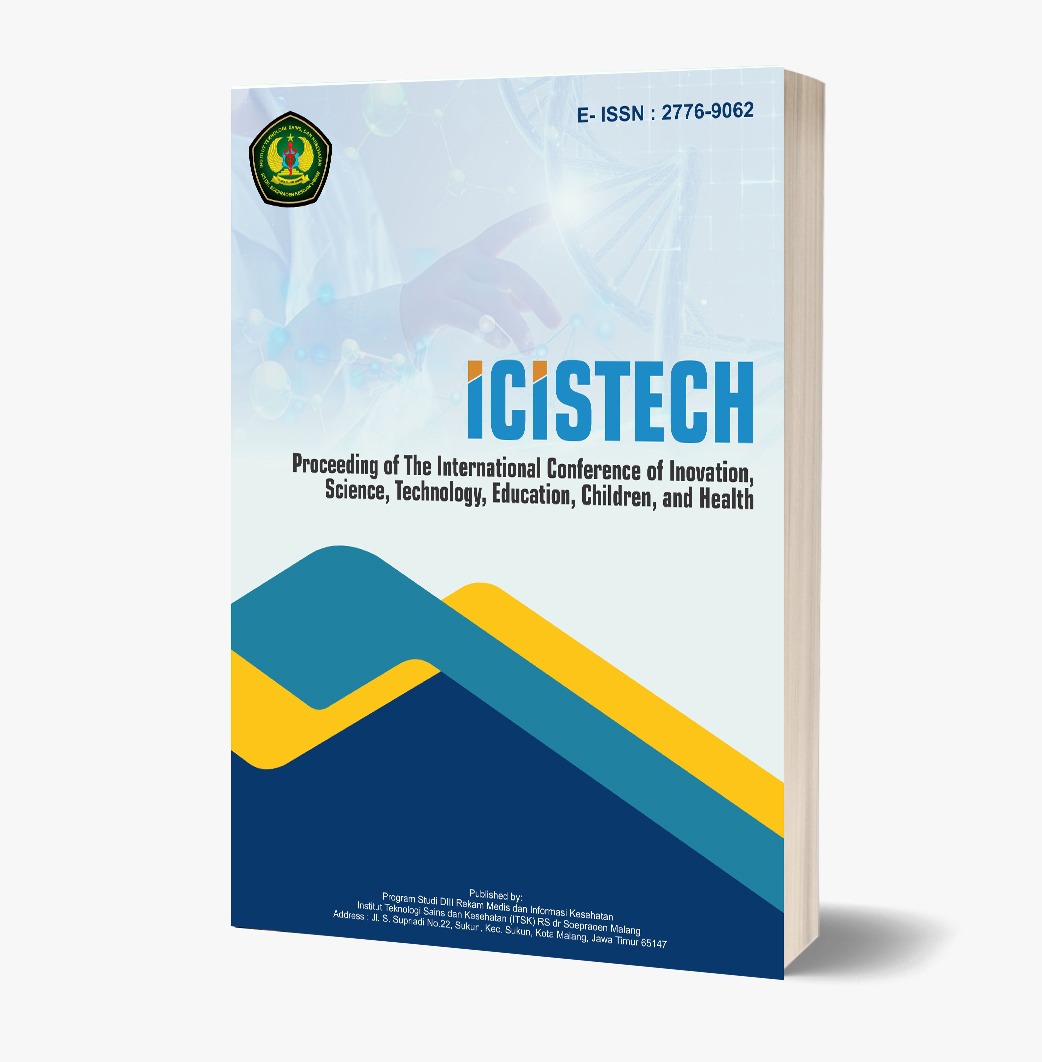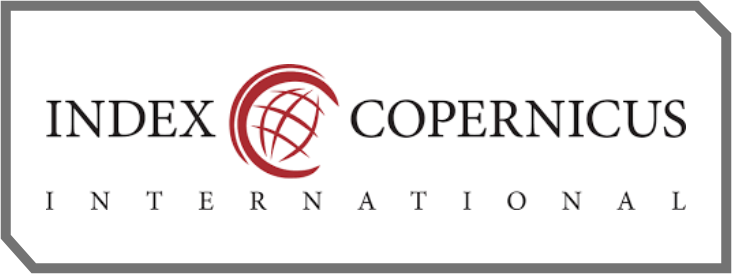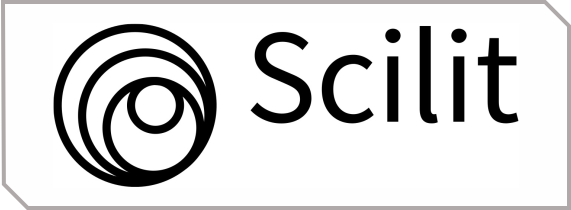Association between Maternal Age and Awarnes of Pregnancy Danger Sign among Pregnant Women
(At the Tapa Health Center, Bone Bolango Regency)
DOI:
https://doi.org/10.62951/icistech.v5i1.212Keywords:
age, knowledge, pregnancyAbstract
Various factors influence pregnant women's knowledge of pregnancy danger signs, including age, education level, occupation, previous pregnancy experience, socioeconomic status, and access to health information. Insufficient knowledge of these signs, often due to limited access to health services and information, increases the risk of delays in managing pregnancy complications, which can negatively impact both maternal and fetal health. The purpose of this study was to explore the relationship between maternal characteristics, specifically age, and awareness of pregnancy danger signs. This quantitative study employed a correlational approach, using a questionnaire as the data collection tool. The study was conducted at the Tapa Health Center in Bone Bolango Regency, from April to August 2024, with 40 participants included. The Spearman statistical test was used to assess the relationship between maternal characteristics based on age and the knowledge of pregnancy danger signs before and after an intervention. The results showed a significant change in the knowledge levels of pregnant women, with the p-value of 0.852 indicating no direct relationship between maternal age and awareness of pregnancy danger signs. Although a positive change was observed in the knowledge levels after the intervention, the study concluded that there was no significant relationship between maternal age and knowledge of pregnancy danger signs. The findings suggest that while interventions can improve awareness, age alone does not appear to be a significant factor influencing knowledge levels. This highlights the importance of focusing on other factors such as education, health access, and targeted health interventions to enhance maternal awareness of pregnancy risks. Further studies with larger sample sizes and additional variables are recommended to provide a more comprehensive understanding of the factors that influence pregnancy-related knowledge.
References
[1] N. Listiyani and Ernawati, “Hubungan tingkat pengetahuan ibu hamil tentang tanda bahaya kehamilan dengan kesiapan persalinan pada ibu hamil trimester iii di puskesmas mojolaban,” 2021.
[2] R. Indriyani, S. Sumarni, and S. Y. S. Salat, “Hubungan Tingkat Pengetahuan Ibu Hamil Dengan Tanda Bahaya Kehamilan Trimester III Di Wilayah Kerja Puskesmas Bluto Kecamatan Bluto Kabupaten Sumenep,” J. Ilmu Kesehat., vol. 3, no. 2, pp. 72–79, 2018.
[3] A. Dewie, “Pengetahuan Dan Sikap Tentang Tanda Bahaya Kehamilan Berhubungan Dengan Pemanfaatan Buku Kia,” JAMBI Med. J. “Jurnal Kedokt. dan Kesehatan,” vol. 9, no. 1, pp. 138–146, 2021, doi: 10.22437/jmj.v9i1.12841.
[4] S. Fatimah and U. Solikhatun, “Gambaran Tingkat Pengetahuan Ibu Hamil Tentang Tanda Bahaya Kehamilan Berdasarkan Karakteristik Ibu Di Desa Sengon Kecamatan Tanjung Kabupaten Brebes,” J. Nurs. Pract. Educ., vol. 1, no. 2, pp. 91–97, 2021, doi: 10.34305/jnpe.v1i2.291.
[5] D. Langapa, “Hubungan Karakteristik Ibu Hamil Dengan Pengetahuan Ibu Hamil Mengenai Kedaruratan Obstetri Di Rumah Sakit Robert Wolter Mongisidi Manado,” J. Keperawatan UNSRAT, vol. 3, no. 2, p. 112248, 2020, [Online]. Available: https://www.neliti.com/id/publications/112248/
[6] F. Hajri and Y. T. Aprillia, “Hubungan Antara Karakteristik Ibu Dengan Pengetahuan Tentang Tanda Tanda Bahaya Kehamilan,” J. Bid. Ilmu Kesehat., vol. III, no. 1, pp. 374–381, 2016.
[7] N. Hajar, J. A. H. Putri, D. Handaria, Y. E. Pandanwangi, and A. Farabi, “Analisis Faktor yang Mempengaruhi Tingkat Pengetahuan Ibu Hamil mengenai Tanda Bahaya Kehamilan di Wilayah Kerja Puskesmas Bandarharjo Kota Semarang,” Pros. Semin. Nas. UNIMUS, pp. 768–775, 2023.
[8] E. Sari and S. Sudarmiati, “Pengaruh Pendidikan Kesehatan Terhadap Tingkat Pengetahuan Ibu Hamil Tentang Tanda Bahaya Kehamilan di Puskesmas Karangdoro,” J. Dep. Keperawatan, vol. 5, no. 3, pp. 1–8, 2020, [Online]. Available: http// ejournal- s1.undip.ac.id%0APengaruh
[9] N. N. Sasnitiari and D. A. Puspitasari, “Hubungan Keikutsertaan Ibu dalam Kelas Ibu Hamil dengan Pengetahuan dan Sikap terhadap Tanda Bahaya dalam Kehamilan di Kota Bogor,” J. Kesehat. Repro, vol. 8, no. 2, pp. 175–185, 2017, doi: 10.22435/kespro.v8i2.6424.175-185.
[10] P. Biru, K. A. B. Bone, and E. P. Korespondensi, “PENGETAHUAN TENTANG TANDA-TANDA BAHAYA KEHAMILAN DI,” 2022.
[11] R. A. Batubara, S. A. ANTIRA, M. Manurung, U. Pasaribu, and H. M. Harahap, “Hubungan Karakteristik Ibu Hamil Dengan Pengetahuan Tentang Tanda Bahaya Pada Kehamilan Di Wilayah Kerja Puskesmas Batang Pane Ii Kecamatan Halongonan Timur Kabupaten Paluta,” J. Kesehat. Ilm. Indones. (Indonesian Heal. Sci. Journal), vol. 8, no. 1, pp. 75–82, 2023, doi: 10.51933/health.v8i1.1030.
[12] A. Kurniawati and D. Nurdianti, “DALAM MENGENAL TANDA BAHAYA KEHAMILAN Prodi D . III Kebidanan Fakultas Ilmu Kesehatan Universitas Muhammadiyah Tasikmalaya Email : adekur@umtas.ac.id Abstrak,” 2010.
[13] B. Safhira and N. Ermi, “Determinants of Pregnancy Complications in Indonesia ( Analysis of Indonesian Health Survey 2023 ),” vol. 09, pp. 764–778, 2024.
[14] E. Yunitasari et al., “Pregnant woman awareness of obstetric danger signs in developing country: systematic review,” BMC Pregnancy Childbirth, vol. 23, no. 1, pp. 1–24, 2023, doi: 10.1186/s12884-023-05674-7.
[15] R. Kundaryanti, S. Dinengsih, and N. Budiani, “Effectiveness of Maternal Class Programme on Knowledge of Pregnancy Danger Signs,” J. Kebidanan Midwiferia, vol. 10, no. 1, pp. 11–18, 2024, doi: 10.21070/midwiferia.v10i1.1686.
[16] K. D. Tjandraprawira and I. Ghozali, “Knowledge of Pregnancy and Its Danger Signs Not Improved by Maternal and Child Health Handbook,” J. Obstet. Gynecol. India, vol. 69, no. 3, pp. 218–224, 2019, doi: 10.1007/s13224-018-1162-0.
[17] V. Budiarti, R. Putri, and C. R. Amelia, “Hubungan Karakteristik Ibu dan Dukungan Suami dengan Tingkat Pengetahuan Ibu Hamil Tentang Tanda Bahaya Kehamilan,” J. Issues Midwifery, vol. 2, no. 1, pp. 1–18, 2018, doi: 10.21776/ub.joim.2018.002.01.1.
[18] Larasati, M. D. (2020). Studi analisis deteksi dini tanda bahaya kehamilan di Puskesmas Kecamatan Senen tahun 2019. Jurnal Kesehatan Mercusuar, 3(2), 1–12. https://doi.org/10.36984/jkm.v3i2.83
Downloads
Published
How to Cite
Issue
Section
License
Copyright (c) 2025 Proceeding of The International Conference of Inovation, Science, Technology, Education, Children, and Health

This work is licensed under a Creative Commons Attribution-ShareAlike 4.0 International License.













